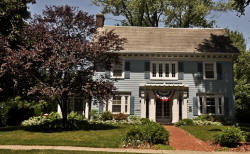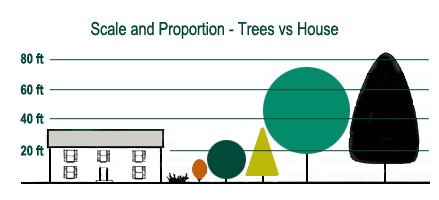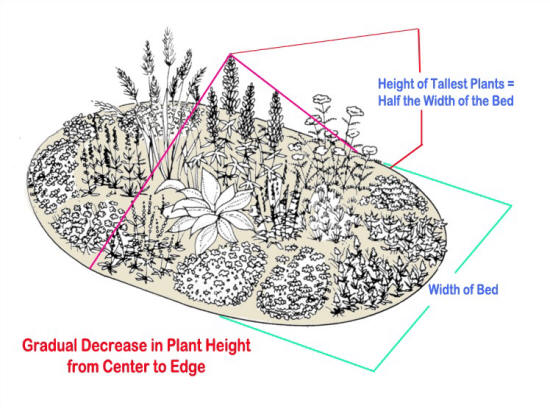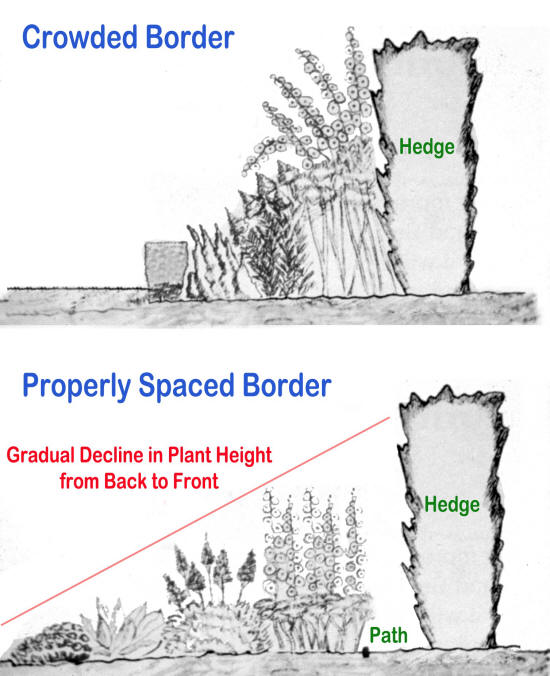In selecting plants for your beds and
borders, the height and spread of the mature plant is
one of those often ignored factors. This will affect how
they fit into your design and how the plants, especially
trees, interact with surrounding buildings and
hardscape.
A. Mature Size - The mature size of trees and shrubs is
of great importance in landscape beds and borders. That
nice little transplant that you bring home from the
nursery may eventually grow into a giant redwood.
Knowing the ultimate size and spread of the plant will
help prevent situations where the trees grow into
distorted shapes because they are planted too close to
the house, fence, or other trees.
 Perhaps the most important reason for long term problems
with pines and spruces discussed earlier is that they
are planted too close to each other. Eventually, their
foliage and root systems grow together and they become
very susceptible to needle diseases and other problems.
Perhaps the most important reason for long term problems
with pines and spruces discussed earlier is that they
are planted too close to each other. Eventually, their
foliage and root systems grow together and they become
very susceptible to needle diseases and other problems.
Knowing the projected mature size of perennials is also
important. This will help you determine the realistic
spacing between plants to allow them to form properly
and not become crowded.
B. Scale and Proportion - Knowing the ultimate height and spread
of your plants will also help you to maintain a proper
sense of scale and proportion in your landscape. Sure,
you have the power of the chainsaw at your disposal but
trying to keep a tree or shrub from growing to its
natural size is usually a losing proposition. You can
keep cutting it down to size but the trunk and side
branches will eventually get out of their natural size
relationship. This will result in an unnatural,
"awkward" looking plant.

C. Beds and Borders - Of course, the key reason for arranging
our plants in beds and borders is to be able to see them
easily and in the right position relative to the other
plants. So, paying attention to the mature height of
plants is important to fulfilling our design intent.
-
Plant Heights for Beds - Beds are free-standing arrangements
where we can walk all the way around and view the plants
from several different perspectives. To be sure that
plants are not blocked by others, we need to place the
tallest plants in the center of the bed and have the
heights drop gradually to the outside of the bed.
The general rule is that the tallest plant should be
about half of the width of the bed in order to appear in
proportion. That would mean that, if the bed is 8 feet
wide, the tallest plant should be no taller than around
4 feet in height.
Also, the term "gradual" decline in height is often
considered to be about a 4 to 8 inch step down with each
layer of plants. That would mean that, if the center
plant is 42 to 48 inches in height, then the plant on
the outside of it should be around 34 to 38 inches tall
so that there isn't an overly large gap between the two.
-
Plant Heights for Borders - By definition, borders have a definite
backdrop to them. The plants are viewed in front of a
building, fence, hedge, wall or other structure. So,
naturally, you would want to put the tallest plants next
to the backdrop with a gradual decline in plant height
toward the front of the border.

As with the case in beds, you want a gradual drop in
height between each row of plants. This will give a
smooth transition from one group of plants to the one in
front of it.
Avoid the "crowded" look by allowing enough room for
each plant to attain its natural size and spread. Also,
it is a good idea to allow a small path or alley between
the back row of plants and the backdrop element. This
will allow for air to move through and help minimize
fungal problems. It will also act as an access point for
maintaining the border without having to step into the
planting areas too much which will compact the soil.



